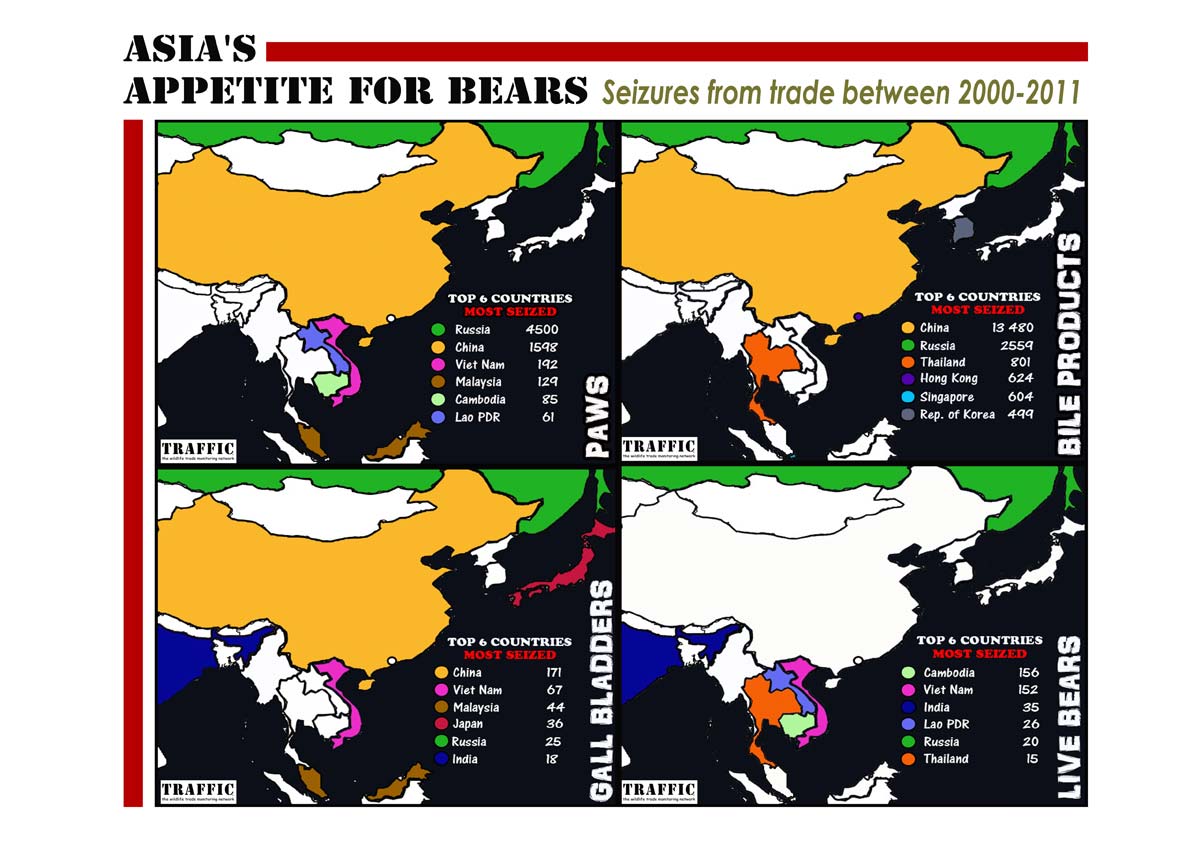Kuala Lumpur, Malaysia, 21st August 2014—A new TRAFFIC analysis of hundreds of seizures sounds the alarm on Asia’s ongoing widespread bear trade and the need for immediate international action.
The findings are published in Brought to Bear: an Analysis of Seizures across Asia (2000–2011) (PDF, 1.1 MB) which studied bear seizures made over a 12-year period in 17 countries and territories across Asia and found that a staggering illegal trade in bears and their parts persists in the region.
The analysis of close to 700 seizures revealed that a minimum of 2,801 individual bears would have been traded for their parts and derivatives between 2000 and 2011. The majority of reported seizures involved Cambodia (190), China (145), Viet Nam (102), Russia (59), Malaysia (38), Thailand (29), Lao PDR (29) and India (23). Bears are traded for a wide range of reasons including live bears to stock bile farms and for the pet or dancing bear trade. Bears are also trafficked for their parts, meat, skins and trophies while their gall bladders and bile are used to manufacture traditional medicines.
The cross-border trade in live bears, and their parts and derivatives violates national laws throughout the region as well as the Convention on International Trade in Endangered Species of Wild Fauna and Flora (CITES). Russia and China alone accounted for 69% of the trade volume equating to a minimum of 1,934 bears, primarily due to the seizure of over 6,000 bear paws. Such significant seizures in Russia and along the border with China suggest a prolific trade in bears and their parts between the two countries.
Important cross border trade routes identified by the analysis include Nepal to India, Lao PDR to Viet Nam and China, Myanmar to China and Thailand and Viet Nam to Japan and Singapore. The confiscation of live bears accounted for 15% of all seizures, making it the second most commonly seized commodity after paws. Significant source countries for live bears included Cambodia and Viet Nam. Live bears seized from border provinces in Cambodia, Lao PDR and Thailand were potentially en route to bear bile extraction facilities, commonly referred to as bear farms.
Significant numbers of gall bladders, commonly used as traditional medicine were also seized. The demand for medicines containing bear bile in Asia is high, driving the trade, and playing a role in the decline of bears in many parts of the Asian region.
“The number of seizures are a credit to the enforcement agencies, but they undoubtedly only stop a fraction of the overall trafficking because bear products are still widely and easily available across Asia,” said Dr Chris R. Shepherd, Regional Director of TRAFFIC in Southeast Asia.
The report recommends that CITES authorities and Parties to the Convention closely examine the latest findings take appropriate steps to assist countries where required, and take a firm stance with countries not complying with the Convention. It calls for improved regional law enforcement efforts, the consistent submission of seizure reports to CITES and for the closure of bear farms stocked with illegally-sourced wild bears. The report also highlights the success of national level, co-ordinated, collaborative efforts such as Cambodia’s Wildlife Rapid Rescue Team in addressing illegal bear trade and recommends that such initiatives be replicated in countries of concern to address threats to bears properly.
“Where enforcement of laws protecting bears is taken seriously, it can be a tremendous deterrent”, said Shepherd.
Source: http://www.traffic.org/home/2014/8/21/parts-of-2800-bears-seized-in-asia-over-a-12-year-period.html


